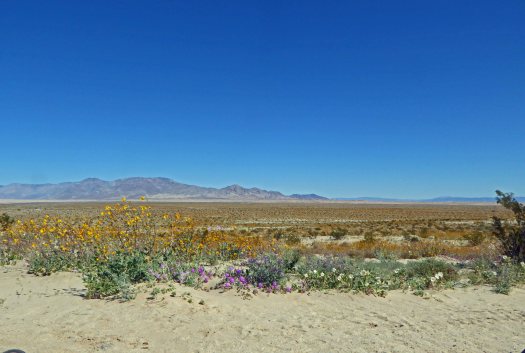There are many wildflowers in the northern section of Anza Borrego Desert Park… and many people vying to see them. When we came to the desert years ago – make that decades ago – we had the desert to ourselves. You just had to make sure you had enough water and gas and brought along some food. Today with social media, nature has become entertainment and people are well-informed as to when the flowers are blooming. To counter this we rented a four-wheel vehicle to go on the back sandy roads, but we weren’t the only ones who thought of that! Still it is a vast area and you only have to hike a little ways up a canyon wash to have the landscape yourself.

-
photo by CCM
Desert lily – a bloom you see after a wet winter. It is found in nature only in the desert areas of the North American southwest – favoring Anza Borrego. Unlike most genera, Hesperocallis is a genus solely for this single species. It is a bulb that can send a stem up to 4 feet high, although these are just getting started. Native Americans used the bulb like garlic.
Tall lupin (Lupinus arizonicus) with desert verbena (Abronia villosa) in the background.
Perhaps my favorite desert flower is the evening primrose – Oenothera.
I’m really not sure if I have ID’ed the two species correctly but I think Oenothera deltoides is taller and Oenothera caespitosa blooms from a basal rosette of leaves. (if anyone has further information I would be grateful.)
Desert sunflowers –Geraea canescens
The caterpillars are coming! The sphinx moth caterpillars (and others) hatch shortly after the first wildflowers and begin munching on the delicate flowers and new shoots. They can decimate 100 acres in a few days. They consider evening primroses (Oenothera) a particular delicacy.
On the positive side when the sphinx moths hatch they pollinate the flowers – and they are attractive don’t you think? I was standing in a patch of verbena and thought I was being buzzed by hummingbirds, but it was the hovering, swift flight patterns of the (2-3”) sphinx moths.

-
They were too fast for my camera so I gratefully borrow this beautiful photo of a sphinx moth (Hyles lineata) fr. Ronnie Pitman.
Verbena landscape with a few sunflowers sprinkled in.
Next week Part II – Central and southern Anza Borrego.
(All photos by CCM unless otherwise credited.)
Wonderful Cinda! We drove down 101 all the way to San Diego and there were some beautiful fields of wildflowers. The mustard plants in particular.
LikeLiked by 1 person
I’m happy to report that I can now again comment on your blog!
>
LikeLike
Did you do anything or did it just start working? Others have written with the same problem and I complained to WP this week. So glad to have you back!
LikeLike
Spectacular, Cinda! Thanks for sharing.
LikeLiked by 1 person
Thank you Cinda for this wonderful visit to the Anza Borrego desert. I loved seeing all the wildflowers, how amazing this must look in person.
LikeLiked by 1 person